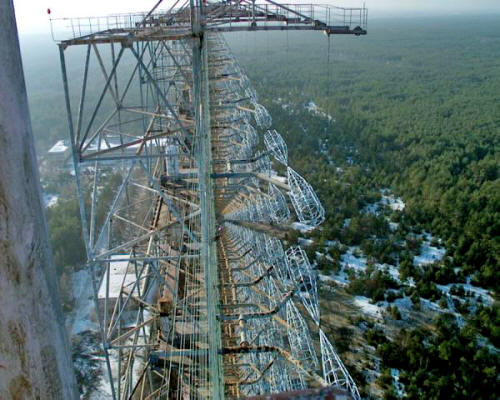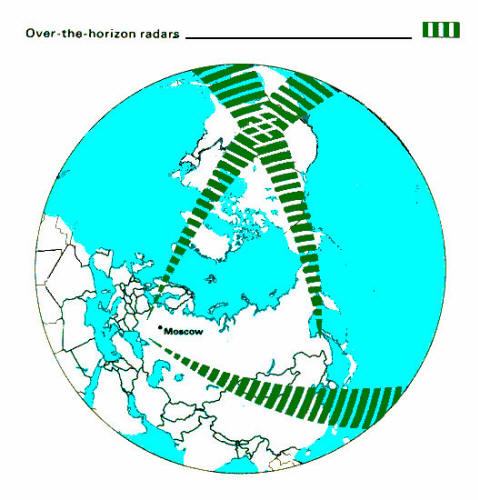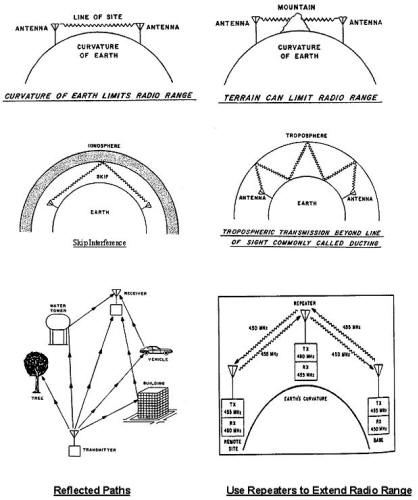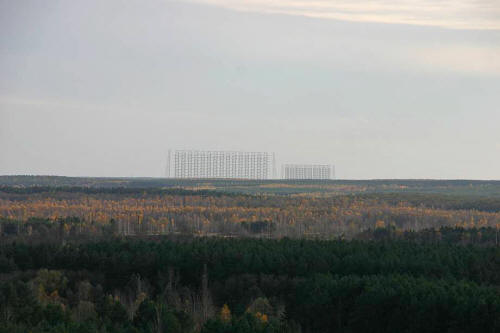|
|
|
April 23, 2010
One of two Duga-3 arrays, this one deep in the Chernobyl Zone of Alienation.
Photo by Wikimedia user Necator,
taken in January of 2003 and released to the public domain.
April 26th is the anniversary of the Chernobyl disaster, and twenty-four years after the accident the area around the plant is still a wasteland.
Everyone who lived in the area was evacuated in the days following and, by and large, they have not been allowed to return (though reportedly a few elderly residents have given in to homesickness and come back to live a clandestine life).
The so-called Zone of Alienation extends for thirty kilometers in every direction, and severe fallout conditions (below image) existed even outside that.
The nuclear plant itself is a silent monument to the Soviet era, but
it just so happens that it’s not the only mysterious site abandoned
because of the accident.
The signal was a sharp set of pulses, up to twenty per second (though usually ten) that was reminiscent of a woodpecker when played over a speaker:
The interference was accordingly dubbed the
Russian Woodpecker, as amateur radio enthusiasts quickly
triangulated the source to an area in what was then the USSR (in the
modern day this is in the “three-corners” region where Ukraine,
Belarus, and Russia meet).
Initial theories to explain the interference - discounting the crazy ones, as the Woodpecker arrived during the mid-1970s UFO craze - assumed that it was deliberate, part of a Soviet plan to jam Western radio, but it soon became clear that Warsaw Pact stations were affected by the Woodpecker too.
It was a side effect of
something else, though it wasn’t at first clear what.
If one assumed,
And there
was reason to assume it was a radar signal: the frequency of the
signal was in the middle of the shortwave band, the only radio
frequencies that are regularly able to bounce off the Earth’s
ionosphere and so travel long distances without drifting off into
space.
Since the Earth is not straight, past a certain distance the curvature of the Earth’s surface hides objects on or near the surface (below image).
The higher the radar source, the further one
can see before this happens - this is one of the reasons why, until
recently, the tallest man-made structures in the world were radio
transmitters like
the CN Tower or the now-defunct
Warsaw Radio
Mast - but for every extra kilometer of desired range a line-of-sight
radar tower has to add an ever-increasing amount of height and it
rapidly becomes unfeasible to build.
This is trickier to do as, while shortwave frequencies will bounce off the ionosphere (and so roughly follow the curve of the Earth instead of a straight line), each bounce depends on the reflectivity of the ionosphere or, on the next reflection, of the ground - and that’s never perfect. Every bounce loses some energy and makes the return signal that much weaker.
For that matter, the resolution of any radar depends on the length of the radio wave it uses; the only radio waves that are reflected off the ionosphere are relatively long, and the level of detail OTH radar shows is measured in kilometers.
Not very good, but if you have an urgent strategic need
to look over continental distances to see if a wave of nuclear
missiles has been launched at you… that the Woodpecker was a Soviet OTH radar watching the US seemed likely.
What the NATO intelligence community did have was more details about the program.
Their name for the project wasn’t random, as they had noticed an immense rectangle of metal girders and wires (below image), 150 meters tall and a kilometer wide, going up not far from the then-obscure Chernobyl nuclear plant.
It was facing north-northwest, the direction from which an American nuclear strike would come, and looked as if it would be able to detect the effect of hot rocket exhaust plumes on the ionosphere - effects large enough to circumvent the low resolution of the radar.
A small town, one of the many the
USSR worked very hard to keep off maps, named
Chernobyl-2 was built
around its base and housed approximately 1000 military and technical
personnel to run the site.
For a while, loosely organized bands of ham radio operators actually worked to spoof the Woodpecker out of frustration that their frequencies were being spammed. They could sometimes get it to change frequency away from their own interference, and even occasionally drive it off the air for a while (presumably because the operators realized they’d never detect anything anyway in the storm of counter-programming).
Eventually, though, a rather different event silenced the Woodpecker
permanently.
When its Reactor #4 melted down, the Woodpecker was heavily contaminated by fallout, and had to be abandoned. Chernobyl-2 was evacuated, and the station’s movable equipment was shipped off to the other Woodpecker in Siberia.
The
main antenna array was far too massive to ship out, so it stayed
behind and (doubly isolated by state secrecy and nuclear radiation)
even provoked rumors that it had somehow caused the meltdown.
The radiation levels are high compared to normal levels, but not immediately dangerous: keep moving, don’t stay too long, and don’t bring any souvenirs out with you, and you’ll be alright. What’s left of the Russian Woodpecker (these days more commonly known by its Russian name, Duga-3 Gomel/Minsk) has attracted the attention of Cold War enthusiasts, aficionados of Soviet mega-engineering, and brave ham radio operators.
After all, where else are you going to get a 150-meter tall antenna just lying around for you to use?
The Woodpecker has also come to the attention
of the tinfoil-hat crowd interested in
HAARP, and in those circles
is believed to have been a weather - or even
mind-control weapon.
Video
HF/ShortWave/HAM Radio Interference
from
YouTube Website
This massive antenna array once was known to cause interference on HF/shortwave frequencies. AKA Woody Woodpecker. This site is located near Chernobyl.
|







